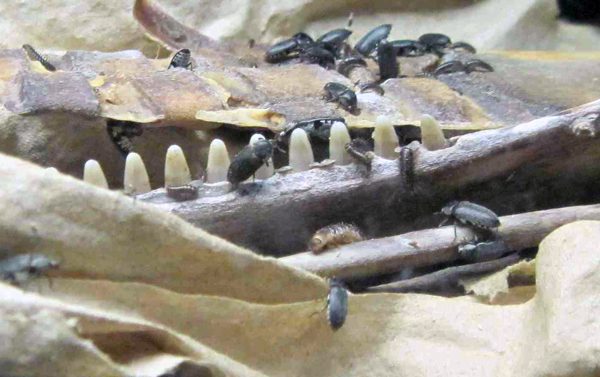Creepy, crawly bone cleaners

The North Carolina Museum of Natural Sciences in Raleigh has an area where you can see through the glass and watch scientists at work, and in this section they also have a couple of glass displays that house a much smaller worker of the creepy crawly variety – dermestid beetles. These beetles have a job to do for the museum, too.
Dermestidae is a family commonly called skin or hide beetles, with 500 to 700 species found across the globe. The word dermistid is a derivation of a Greek word for skin. (Think epidermis, the outer layer of skin). They are scavengers and feed on dry plant and animal material including fur, hair, feathers, flesh, and fibers. As such, they are frequently used in museums and taxidermy to clean animal skeletons. They are small, black or brown in color, and typically hairy.
The beetles eat dead flesh and other materials and leave only the bones behind, a process also known as “skeletonizing.” This is a much better method than boiling, burying or using chemicals, as these can damage the bone, even turning it yellow or grey, and otherwise negatively affect the integrity or strength and the overall ability to use them for scientific research.
The species on display at the Natural Science museum in Raleigh is Dermestes maculatus. A colony of hundreds of these little guys was working away on a dolphin skull and a groundhog in the tank I saw on display (pictured above). They like it cool, moist, and dark. Damp paper towels were used to help keep conditions favorable. They are a hardy species that is fairly easy to maintain. The fact that they can’t fly at room temperature makes them a good fit for museums and for the display because they won’t easily escape. This species also can reproduce quickly, important because the larvae do a lot of the more intricate work, and can live for up to five months.
Dermistid beetles are also significant for forensic science. They typically arrive 5 to 11 days after death, and their presence can help give an indication of postmortem interval (time of death), and as a result can be helpful in criminal investigations. They can also be used by wildlife law enforcement to protect integrity of evidence.
Unfortunately, they can also be a pest, as an infestation of them may feed on old books, carpets, silk and wood. If they were to get out of their museum enclosures, they could damage other specimens, so they are kept away from these and closely monitored.
Overall though, these beetles provide a very low-tech and cost effective way to clean skeletons for research and investigation, and as such are another great example of how species help us. Be sure to check out this display next time you visit the museum and learn more about these creepy crawly bone cleaners.